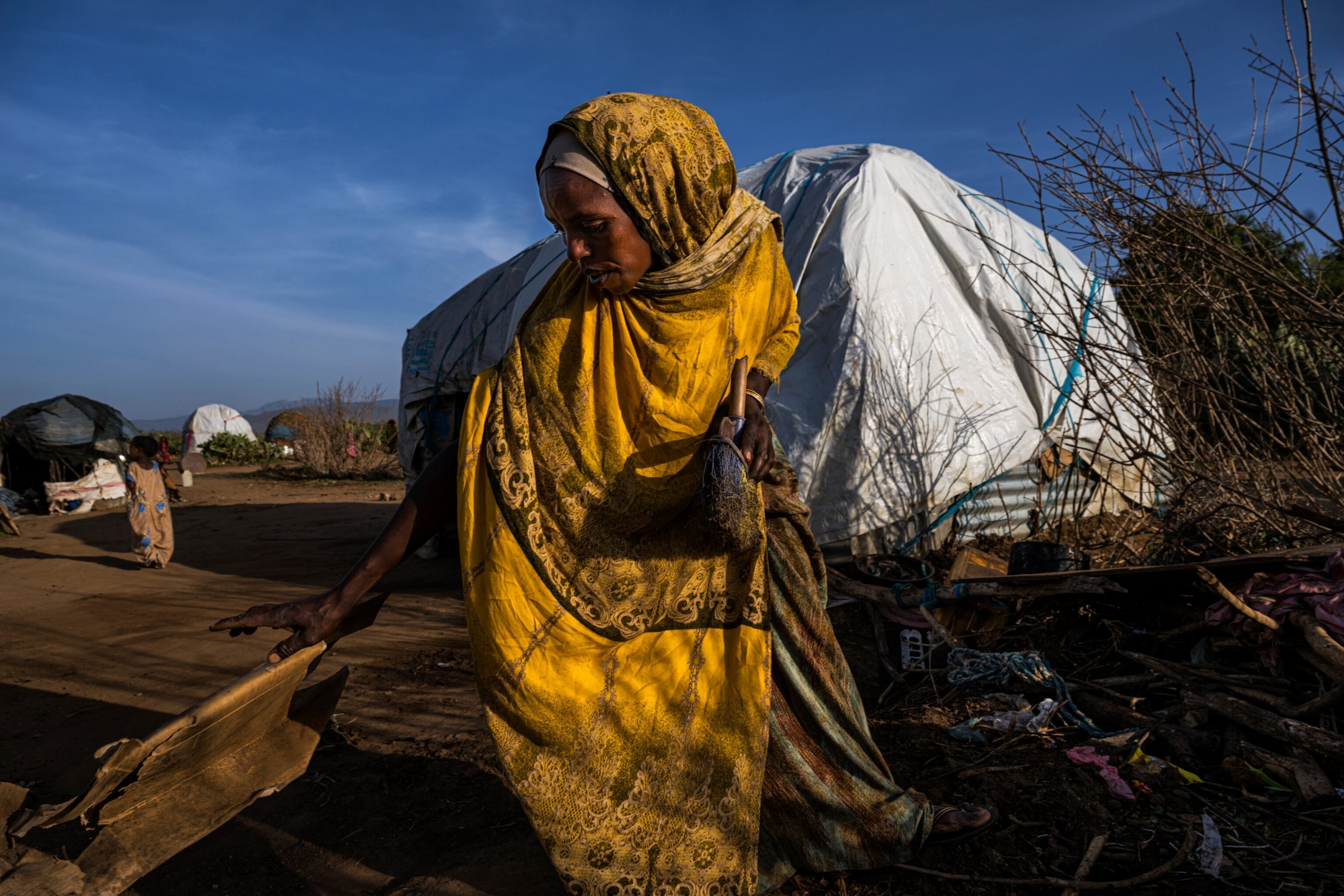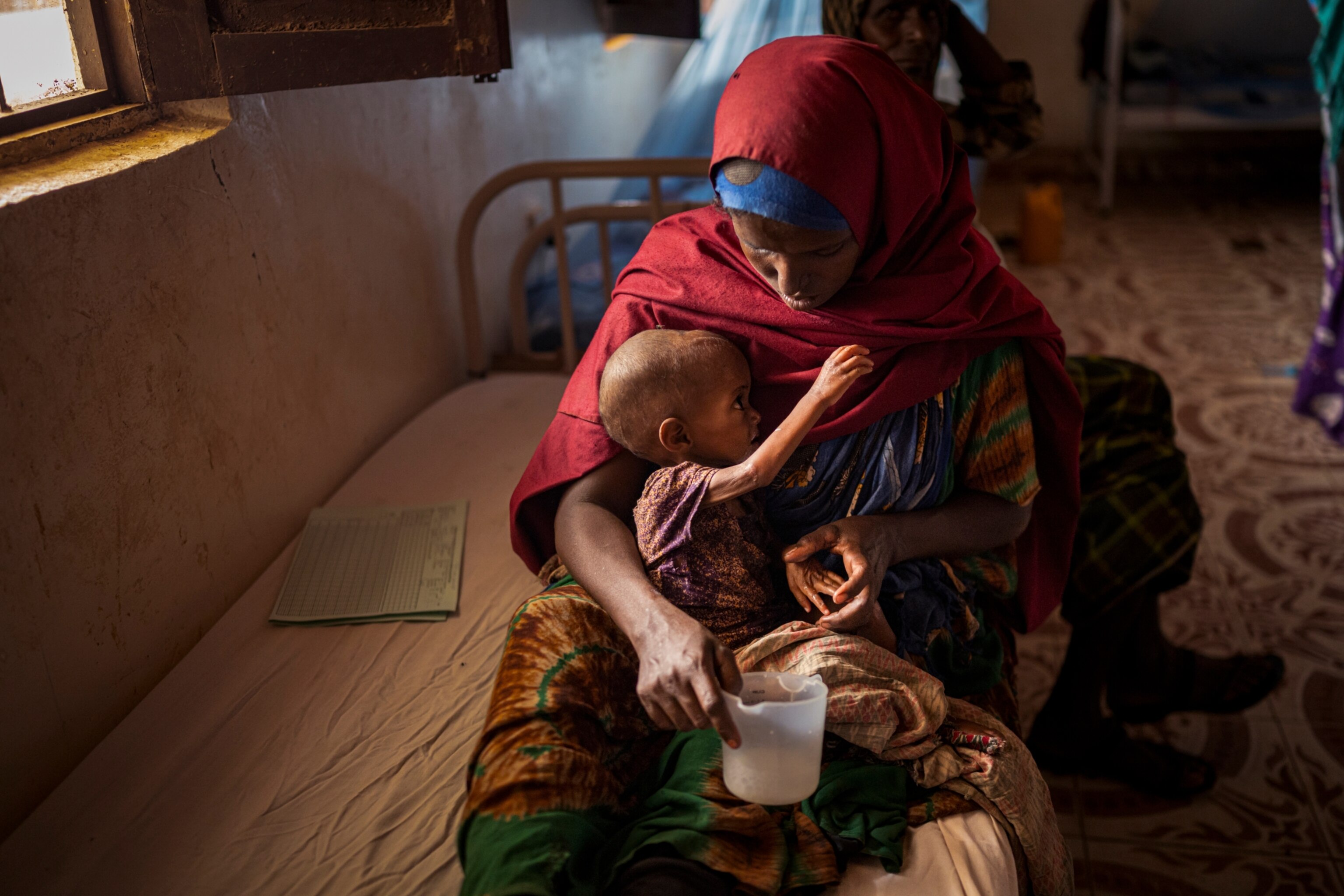
Inside the Horn of Africa’s hunger crisis
Drought, conflict, instability, and rising prices are creating unprecedented levels of food insecurity and looming famine, photojournalist reports.




Baidoa, Somalia — In a makeshift shelter at one of the many camps for those displaced by the relentless drought punishing the Horn of Africa, Edaba Yusuf watches over the tiny body of her four-year-old son, Salman Mohamed Abdirahman, who died that morning from severe malnutrition and measles. He is the third child the mother of eight has lost to hunger in less than four weeks.
Two of her boys died in their village in southwestern Somalia, which prompted the family to travel to Baidoa—a city surrounded by the al-Shabaab militant group but still accessible to humanitarian agencies that provide food, water, and medical treatment to help alleviate some of the desperation.


“They were hungry, and I had nothing to sell,” says Yusuf. “I thought to myself, ‘let me move to where I can get humanitarian assistance before I lose the rest.’”
Three of her five remaining children are now sick with measles.
"We were among the nomadic pastoralists with livestock but most of the livestock died in the droughts. We live at the mercy of God and we need assistance from fellow brethren."Hafsa Mohamed Musa


The lack of rain, ongoing conflict, political instability, and soaring food prices driven up by the war in Ukraine, are bringing hunger and food insecurity to critical levels to countries on the easternmost part of the African continent.
With the worst drought to hit the area in four decades, many communities are experiencing unprecedented levels of food shortage, spurring a malnutrition emergency across the Horn of Africa, including, Kenya, Ethiopia, and Somalia. More than 37 million people—including an estimated seven million children—are on the verge of famine, according to various aid organizations.
"The scale and urgency of the global climate crisis are unprecedented. While overwhelming, now is the moment when bold collective action is needed. We must save lives while simultaneously supporting communities on the front lines of the global climate crisis to become more resilient against the climatic shocks that we know will continue to worsen in the years to come."Sean Granville-Ross, Regional Director for Africa, Mercy Corps
The crisis comes as world leaders prepare to gather in Sharm El Sheikh, Egypt on November 6 for the 27th session of the Conference of the Parties to the United Nations Framework Convention on Climate Change (UNFCCC). At the COP27, participating countries negotiate their commitments to reduce greenhouse gas emissions as the Earth experiences more devastating natural disasters and species extinction as well as growing food demand and water scarcity.




“Across East Africa, we are seeing that the people who did the least to cause climate change are suffering the most from its effects,” says Sean Granville-Ross, Mercy Corps regional director for Africa. “Communities are experiencing the severe impacts of the climate crisis in many forms such as severe drought. And conversely, in some areas, flooding, changing weather patterns, and its impacts are undermining food production and traditional livelihoods.”
“When I first came, they were drinking so much milk… I saw naughty boys throwing milk at each other, fooling around...Now, the situation is such that to find enough milk for the bottom of the cup to make milk tea is nearly impossible.”Valerie Browning, Program Coordinator, Afar Pastoralist Development Assoc.
“The international community should act quickly and provide immediate emergency funding to sustain and significantly scale up the response to help prevent thousands of children from dying from hunger,” says Said Mohamud Isse, national media and communications advisor for Save the Children’s Somalia Country Office.
The scenes portray a calamitous situation.

Somalia, which relies on grain imports from Ukraine, is facing the most extreme conditions as food and fuel prices continue to rise with the war. The lack of rain has decimated crops, livestock are dying in high numbers, more than 500,000 children under the age of five are severely malnourished, some 300,000 people are facing a catastrophic level of food shortage, and an estimated 1.1 million people are displaced by the current crisis.

In Baidoa, an estimated 600,000 displaced people are spread across some 500 separate camps. In one of them, Khadija Muali crouches in the hot shade with dozens of other women and children who had just arrived from a rural town southeast of the city after walking for one week with her children in search of food and water.
Muali had four children when she left Dinsor. Now, she has two: “My children died along the way from hunger and fatigue.” Her three-year-old daughter, Hawa Lul, passed away on the first day of their trek; seven-year-old Abdul Rasaq on the fourth. Other villagers helped her bury them along the road.



“When you see your child crying because of lack of food, and there is conflict, and no possibility of casual work,” she says, “what do you do?”
Hafsa Mohamed Musa, a mother of five children, has been living in a displacement camp for six months while her husband tries to earn an income elsewhere.
“We were among the nomadic pastoralists with livestock but most of the livestock died in the droughts,” she says, adding that the family had previously led a good life.
“In the past, there was plenty. We used to milk the livestock, sold some, and slaughtered some for getting meat. Then there came a two-year consecutive drought. The goats we had could not get pasture,” she says. “After the drought has set in, our lives have been difficult. We live by the handouts from well-wishers.”
A grave humanitarian crisis also is unfolding in Ethiopia, which is struggling with a vicious civil war in the north and devastating climate-change effects in the south. Prolonged drought has wiped out livestock, driven displacement, and altered families’ ability to make a living.


At least 5.2 million people are urgently in need of food support, about three million children are at risk of malnutrition, and more than 3.5 million people don’t have access to safe drinking water.
“When I first came, they were drinking so much milk… I saw naughty boys throwing milk at each other, fooling around,” says Australian nurse Valerie Browning, program coordinator for the Afar Pastoralist Development Association in Ethiopia, who has lived among the Afar nomads for more than three decades. “Now, the situation is such that to find enough milk for the bottom of the cup to make milk tea is nearly impossible.”

Related Topics
You May Also Like
Go Further
Animals
- How scientists are piecing together a sperm whale ‘alphabet’How scientists are piecing together a sperm whale ‘alphabet’
- Orangutan seen using plants to heal wound for first timeOrangutan seen using plants to heal wound for first time
- What La Palma's 'lava tubes' tell us about life on other planetsWhat La Palma's 'lava tubes' tell us about life on other planets
- This fungus turns cicadas into zombies who procreate—then dieThis fungus turns cicadas into zombies who procreate—then die
Environment
- This floating flower is beautiful—but it's wreaking havoc on NigeriaThis floating flower is beautiful—but it's wreaking havoc on Nigeria
- What the Aral Sea might teach us about life after disasterWhat the Aral Sea might teach us about life after disaster
- What La Palma's 'lava tubes' tell us about life on other planetsWhat La Palma's 'lava tubes' tell us about life on other planets
- How fungi form ‘fairy rings’ and inspire superstitionsHow fungi form ‘fairy rings’ and inspire superstitions
- Your favorite foods may not taste the same in the future. Here's why.Your favorite foods may not taste the same in the future. Here's why.
- Are the Great Lakes the key to solving America’s emissions conundrum?Are the Great Lakes the key to solving America’s emissions conundrum?
History & Culture
- These were the real rules of courtship in the ‘Bridgerton’ eraThese were the real rules of courtship in the ‘Bridgerton’ era
- A short history of the Met Gala and its iconic looksA short history of the Met Gala and its iconic looks
- Meet the ruthless king who unified the Kingdom of Hawai'iMeet the ruthless king who unified the Kingdom of Hawai'i
- Hawaii's Lei Day is about so much more than flowersHawaii's Lei Day is about so much more than flowers
Science
- Why ovaries are so crucial to women’s health and longevityWhy ovaries are so crucial to women’s health and longevity
- Orangutan seen using plants to heal wound for first timeOrangutan seen using plants to heal wound for first time
Travel
- Why this unlikely UK destination should be on your radarWhy this unlikely UK destination should be on your radar







